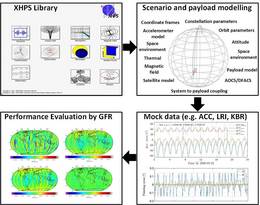
CRC 1464 TerraQ B02
The CRC 1464 “Relativistic and Quantum-based Geodesy” is funded by the Deutsche Forschungsgemeinschaft (DFG).
The first funding period of the SFB will extend from Jan 1, 2021 to Dec 31, 2024. In this period, TerraQ consists of 19 projects at 6 participating institutes.
The aim of TerraQ is to optimize the geodetic mass observation measurements from space and on ground. TerraQ will advance the frontiers of quantum measurements on ground, the metrology and modeling of space gravimetry as well as gravity modelling and its application.
B02 in particular aims to develop the central modelling testbed for new satellite gravimetry concepts researched in this CRC in form of a multi-purpose space mission simulator. This simulation tool can generate realistic mock data on sensor and system level by incorporating full-scale satellite models and their interactions with the environment. With a focus on a generic simulation ansatz multiple types of prospective future gravity missions including GRACE-like concepts, swarm scenarios and formation flight can be investigated. A full set of mock data includes (i) science data, (ii) house keeping, (iii) Attitude and Orbit Control System (AOCS), (iv) satellite states, and (v) navigation solution support.
The simulaton tool also aids in improvements in Gravity Field Recovery (GFR). In employing advanced gravity field recovery schemes in conjunction with the mission simulation we effectively realise a closed-loop performance analysis for satellite gravimetry. The uncovering of discrepancies in numerical models and evaluation schemes will benefit both the quality of the modelling as well as the further development of enhanced methods for gravity field recovery for new mission concepts.
GRACE-FO serves as a reference mission for developments to increase simulation performance, like more precise determination of model parameters. For example, for GRACE-FO a procedure is developed that estimates the thermospheric density at satellite positions, which increases the performance of accelerometer mock data compared to density values from atmospheric models. Following this, is a physically motivated transplant procedure is developed that enable B02 to generate high-fidelity gravity field solutions from artificial accelerometer data.
Furthermore, we focus on integration of novel sensor concepts into GFR schemes using the end-to-end simulation capabilities of B02. This also includes preliminary mission and attitude design for the novel sensor concepts as well as investigation of sensor specific noise models. One sensor concept is realised as a space-born optical clock, whose frequency is depending on the gravitational potential among other things, which makes it a potential sensor candidate for future gravity missions.
Based on the inputs of the other projects in this CRC concentrating on new mission and sensing concepts, data evaluation schemes as well as specifics of hardware, B02 realises a complete end-to-end simulation of each concept allowing for a global performance evaluation and optimisation strategies. By this B02 takes an important step towards the definition of future candidates for satellite gravimetry missions.


 "
"